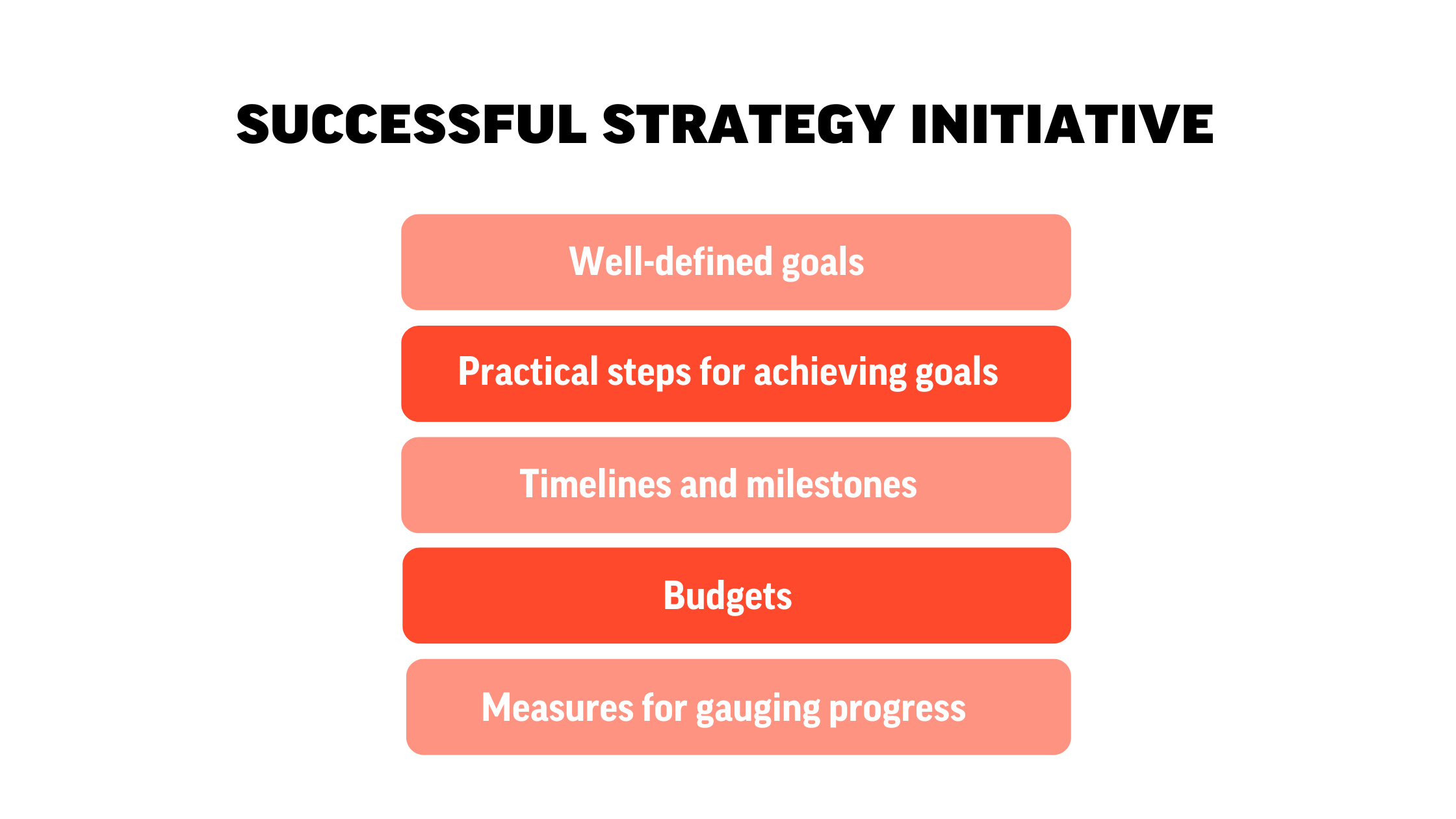What Are Strategic Initiatives and How To Prioritize Them
.png)
A business without strategic initiatives is both rudderless and without a planned route or even a map. Strategic Initiatives are the way a company turns its goals into successful reality.
No strategic initiatives means the very best aims and visions will remain nothing more than ideals and intentions - neither of which can sustain a business for very long on their own.
In this article we will be looking at what strategic initiatives are, how they are created, prioritized and tracked.
What are strategic initiatives?
Strategic initiatives are comprehensive plans that an organization sets out for achieving its strategic goals and long-term visions for improvement. They are developed and deployed in line with the company’s top strategic priorities. The goal will state what you want to achieve, but it is the strategic initiative that explains how you achieve it. They are the means by which plans become a method-based reality. Therefore the conception, creation and delivery of any strategic initiative is crucial to a business outcome.
Strategic initiatives can comprise multiple projects and several strategic initiatives can function together to achieve a larger more visionary goal. An organization can analyze current projects and determine how well they align with its strategic goals and remove any that offer no impact on the goals and may even detract from their success.
A successful strategy initiative will generally include:

There’s a very good acronym to cover the ingredients of strategic initiatives - SMART
S.Specific - Know your specific goals and aspirations
M.Measurable - Track your progress
A.Attainable - Your goals can’t be fantasy, make them achievable
R.Relevant - The goal must relate to the company aspirations T.
T.Time-based - Goals need a deadline, to work towards and measure progress against
How to develop strategic initiatives
Strategic initiatives can evolve in may ways. They can be the result of market research, of customer/client or supplier feedback. They can stem from focused management brainstorms and can even be generated by a response to external events that were perhaps unforeseen - Covid lockdowns being an example, or rapid technology shifts and customer behaviour changes.
Whatever the spark and ignition of strategic initiatives, the move from identification, discussion and ideas to creation and implementation is crucial but can be protracted and daunting.
1. Identify your goals
What are your priorities and the aims related to them? What projects and undertakings are aligned with those aims and what are the obstacles or the missing elements impeding the path to those goals? Target the impediments the company is best able to resolve and that will have the biggest impact.
2. Checkpoints
Set checkpoints or milestones. This is like an orienteering course. Each stage is achieved ticked off and is a measurable step further towards the goal and task completion. As each one is attained, work begins on the next. These milestones might be a specific number of sign-ups, PR coverage with calls to sign-up action. It might be a particular percentage increase in revenue so a sales initiative is launched.
3. A Strategy
A strategy is what you hitch up to and ride on to take you towards your business goals. Clearly defined and properly executed, it can provide a smooth and efficient ride on that journey. A strategy can have many strands and the essential thing is to have every aspect of it thought through, clearly mapped out, aligned with your team and well communicated and with room for it to evolve as necessary.
4. The Plan
The plan sets out the steps you must take for your strategy to work and your goals to be achieved. Relating to the milestones, the plan can be broken down into its individual segments with deadlines, responsibilities and an individual heading it up. This can be shared with employees and management to ensure good communication and clear direction.
5. Support
Without internal support from management and executives it will be very hard to properly execute a strategic initiative and see it though to a positive conclusion. Convesely, their support means you will be best positioned to reward that support by delivering on the plans and promises. This crucial support can be garnered by outlining the the vision clearly, the end goals and benefits and by evoking the company’s standards and values - appealing to a commonly shared emotional attachment, prestige and reputation.
6. Monitoring the Situation
As with all matters of strategy, it is crucial to keep a close eye on activities, actions and progress. Regular reports and updates on progress will mean constant evaluations can be made, tweaks to the strategy applied as required and timings for completions are properly recorded. This monitoring is also vital for keeping everybody informed and engendering the support mentioned in the above paragraph.
Strategic initiatives examples
To give an idea of strategic initiatives at work, let’s have a look at some high profile examples. It is also worth noting what all successful strategic initiatives have in common:
* Transformative - They create change, they often involve doing something different
* Staging posts or Scopes will be well defined - These are the microcosms with the vision as a whole, the personnel, resources, timings for start and completion.
* The Vision - As stated previous, a strategic initiative is all about turning a vision into a reality by giving it a path and a series of defined actions and activities.
* Close the gap - Narrow the distance, or even eliminate the gap between ideal results and the results you are actually achieving. Develop a plan and timeline for closing the gap from where you are, to where you want to be.
They also require discipline, focus and relevance - initiatives must be fully aligned to the key priorities.
High profile examples of strategy initiatives include:
Their commitment to hardware, software and services allowing them to create an entire ecosystem and dominate a market.
Netflix - A massively successful transition from DVDs rentals to a global streaming giant. (Unlike Blockbuster which turned down the opportunity to buy Netflix early and vanished from the high street)
Amazon - Redefined e-commerce by focusing on vast product availability, total convenience and a huge emphasis on customer satisfaction.
McDonalds - While the favorites remain, they constantly evolve their menu to reflect customer preferences and also introducing healthier options.
How to prioritize strategic initiatives
Prioritizing strategic initiatives requires a structured approach to maximize their impact on an organization’s goals. Start by aligning initiatives with your vision and mission, making sure they contribute to core objectives. Evaluate each initiatives potential ROI (return on investment) considering timeframe, short term gains and long term value.
Feasibility and resource availability - Ensure you have the required skills, personnel, budget and means in place. Looking at your strategic initiatives, rank them on their alignment with market trends and the competitive landscape and estimate potential risks and rewards. Also evaluate the impact of either delaying or accelerating each initiative.
Finally, set in place a method of detailed and regular review, maintaining open channels to ensure good communication and regular feedback.
How to track strategic initiatives
A company that stands still and stagnates runs the very real risk of being consigned to history. Smart strategizing and implementing is crucial to avoiding this fate, so too is tracking.
Stubbornly sticking to a plan can be fatal in business terms. It is vital to be flexible to adapt and adopt on the move and evolve a strategy initiative as you work towards your goal. There are external events that mean nothing can be rigidly set in stone - business environments change, national and global situations change, suppliers and customers change.
Tracking strategic initiatives and regular assessment is key to staying on target and being responsive and agile.
No matter what Strategy Execution Tool you use, always schedule a detailed assessment on a bi-monthly basis, for example, to ascertain what has happened since the previous meeting, have tasks been achieved, targets and timelines met? Tracking strategic initiatives is crucial for progress, to identify issues, make informed adjustments, find potential solutions and address challenges promptly and effectively.
Establish clear key performance indicators (KPIs). These must align with the objectives of each initiative. Regular monitoring of these KPIs will allow a business to gather relevant data and use tools like strategy and project management software.
Using a balanced scorecard approach means a company is able to track the various elements of a strategic initiative such as financial, customer, operational and growth metrics. This holistic view provides the best overview and prevents focusing on one dimension while neglecting others.
Assign responsibility. Designate initiative owners who are accountable for tracking and reporting progress. And with a culture of transparency and accountability, team members will be encouraged to speak up, raise concerns and propose improvements.
Regularly analyze data to identify trends and patters. If an initiative is falling behind, investigate root causes and adjust strategy accordingly. And remember to celebrate achieved milestones!
Conclusion
The success of a strategic initiative is not down to a single action or even one project, it is a combination of numerous elements executed effectively with these bullet points in common.
• Identify your priorities prior to creating your initiatives
• You have limited resources, don’t create too many initiatives
• Stay focused and and steer clear of distractions that divide your focus and resources
• Develop SMART initiatives
• Make them informative and assign an owner


.png?width=596&name=Financial%20Crisis%20(1).png)






.png?width=80&name=USED%20(1).png)